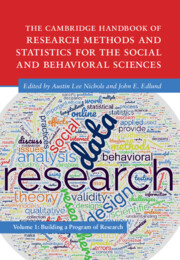 The Cambridge Handbook of Research Methods and Statistics for the Social and Behavioral Sciences
The Cambridge Handbook of Research Methods and Statistics for the Social and Behavioral Sciences Book contents
- The Cambridge Handbook of Research Methods and Statistics for the Social and Behavioral Sciences
- Cambridge Handbooks in Psychology
- The Cambridge Handbook of Research Methods and Statistics for the Social and Behavioral Sciences
- Copyright page
- Dedication
- Contents
- Figures
- Tables
- Contributors
- Preface
- Part I From Idea to Reality: The Basics of Research
- Part II The Building Blocks of a Study
- Part III Data Collection
- Part IV Statistical Approaches
- 21 Data Cleaning
- 22 Descriptive and Inferential Statistics
- 23 Testing Theories with Bayes Factors
- 24 Introduction to Exploratory Factor Analysis: An Applied Approach
- 25 Structural Equation Modeling
- 26 Multilevel Modeling
- 27 Meta-Analysis
- 28 Qualitative Analysis
- Part V Tips for a Successful Research Career
- Index
- References
21 - Data Cleaning
from Part IV - Statistical Approaches
Published online by Cambridge University Press: 25 May 2023
- The Cambridge Handbook of Research Methods and Statistics for the Social and Behavioral Sciences
- Cambridge Handbooks in Psychology
- The Cambridge Handbook of Research Methods and Statistics for the Social and Behavioral Sciences
- Copyright page
- Dedication
- Contents
- Figures
- Tables
- Contributors
- Preface
- Part I From Idea to Reality: The Basics of Research
- Part II The Building Blocks of a Study
- Part III Data Collection
- Part IV Statistical Approaches
- 21 Data Cleaning
- 22 Descriptive and Inferential Statistics
- 23 Testing Theories with Bayes Factors
- 24 Introduction to Exploratory Factor Analysis: An Applied Approach
- 25 Structural Equation Modeling
- 26 Multilevel Modeling
- 27 Meta-Analysis
- 28 Qualitative Analysis
- Part V Tips for a Successful Research Career
- Index
- References
Summary
High-quality data are necessary for drawing valid research conclusions, yet errors can occur during data collection and processing. These errors can compromise the validity and generalizability of findings. To achieve high data quality, one must approach data collection and management anticipating the errors that can occur and establishing procedures to address errors. This chapter presents best practices for data cleaning to minimize errors during data collection and to identify and address errors in the resulting data sets. Data cleaning begins during the early stages of study design, when data quality procedures are set in place. During data collection, the focus is on preventing errors. When entering, managing, and analyzing data, it is important to be vigilant in identifying and reconciling errors. During manuscript development, reporting, and presentation of results, all data cleaning steps taken should be documented and reported. With these steps, we can ensure the validity, reliability, and representative nature of the results of our research.
- Type
- Chapter
- Information
- The Cambridge Handbook of Research Methods and Statistics for the Social and Behavioral SciencesVolume 1: Building a Program of Research, pp. 443 - 467Publisher: Cambridge University PressPrint publication year: 2023
References
- 5
- Cited by
